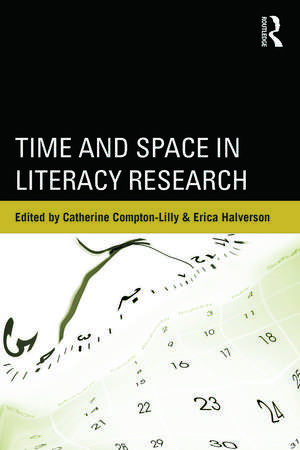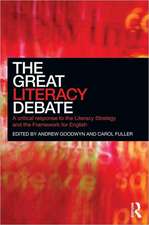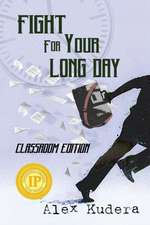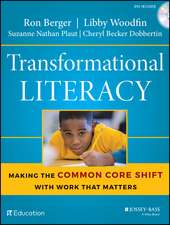Time and Space in Literacy Research
Editat de Catherine Compton-Lilly, Erica Halversonen Limba Engleză Paperback – 8 mai 2014
| Toate formatele și edițiile | Preț | Express |
|---|---|---|
| Paperback (1) | 301.71 lei 6-8 săpt. | |
| Taylor & Francis – 8 mai 2014 | 301.71 lei 6-8 săpt. | |
| Hardback (1) | 695.60 lei 6-8 săpt. | |
| Taylor & Francis – 7 mai 2014 | 695.60 lei 6-8 săpt. |
Preț: 301.71 lei
Nou
Puncte Express: 453
Preț estimativ în valută:
57.77€ • 59.53$ • 48.48£
57.77€ • 59.53$ • 48.48£
Carte tipărită la comandă
Livrare economică 21 februarie-07 martie
Preluare comenzi: 021 569.72.76
Specificații
ISBN-13: 9780415749886
ISBN-10: 0415749883
Pagini: 224
Ilustrații: black & white illustrations
Dimensiuni: 152 x 229 x 12 mm
Greutate: 0.32 kg
Ediția:New.
Editura: Taylor & Francis
Colecția Routledge
Locul publicării:Oxford, United Kingdom
ISBN-10: 0415749883
Pagini: 224
Ilustrații: black & white illustrations
Dimensiuni: 152 x 229 x 12 mm
Greutate: 0.32 kg
Ediția:New.
Editura: Taylor & Francis
Colecția Routledge
Locul publicării:Oxford, United Kingdom
Cuprins
Foreword: Allan Luke
Introduction: Conceptualizing Past, Present, and Future Timespaces
Section 1: Timespaces and the Past in Literacy Research
Introduction
Chapter 1: Thank You, Mrs. Whitehouse: The Memory Work of One Student about His High School English Teacher, Forty Years Later
Johnny Saldaña
Chapter 2: Invoking Modalities of Memory in the Writing Classroom
Juan C. Guerra
Chapter 3: "It’s about Living Your Life": Family Time and School Time as a Resource for Meaning Making in Homes, Schools and Communities
Kate Pahl
Chapter 4: Uses of Collective Memories in Classrooms for Constructing and Taking Up Learning Opportunities
Margaret Grigorenko, Marlene Beierle, & David Bloome
Section 2: Timespaces and the Present in Literacy Research
Introduction
Chapter 5: Write on Time! The Role of Timescales in Defining and Disciplining Young Writers
Lorraine Falchi & Marjorie Siegel
Chapter 6: How Moments (and Spaces) Add up to Lives: Queer and Ally Youth Talking Together about LGBTQ-Themed Books
Mollie V. Blackburn & Caroline T. Clark
Chapter 7: Lost Voices in an American High School: Sudanese Male English Language Learners’ Perspectives on Writing
Bryan Ripley Crandall
Chapter 8: Spatializing Social Justice Research in English Education
sj Miller
Section 3: Timespaces and the Future in Literacy Research
Introduction
Chapter 9: Remixes: Time + Space in Youth Media Arts Organizations
Michelle Bass
Chapter 10: The Roles of Time and Task in Shaping Adolescents’ Talk about Texts
James S. Chisholm
Chapter 11: "After Apple Picking" and Fetal Pigs: The Multiple Social Spaces
and Embodied Rhythms of Digital Literacy Practices
Kevin M. Leander & Beth Aplin
Chapter 12: The Compression of Time and Space in Transnational Social Fields: Mobilizing the Affordances of Digital Media with Latina Students
Lisa Schwartz, Silvia Noguerón-Liu, and Norma Gonzalez
Afterword: The time-space double helix of research
Jennifer Rowsell
Introduction: Conceptualizing Past, Present, and Future Timespaces
Section 1: Timespaces and the Past in Literacy Research
Introduction
Chapter 1: Thank You, Mrs. Whitehouse: The Memory Work of One Student about His High School English Teacher, Forty Years Later
Johnny Saldaña
Chapter 2: Invoking Modalities of Memory in the Writing Classroom
Juan C. Guerra
Chapter 3: "It’s about Living Your Life": Family Time and School Time as a Resource for Meaning Making in Homes, Schools and Communities
Kate Pahl
Chapter 4: Uses of Collective Memories in Classrooms for Constructing and Taking Up Learning Opportunities
Margaret Grigorenko, Marlene Beierle, & David Bloome
Section 2: Timespaces and the Present in Literacy Research
Introduction
Chapter 5: Write on Time! The Role of Timescales in Defining and Disciplining Young Writers
Lorraine Falchi & Marjorie Siegel
Chapter 6: How Moments (and Spaces) Add up to Lives: Queer and Ally Youth Talking Together about LGBTQ-Themed Books
Mollie V. Blackburn & Caroline T. Clark
Chapter 7: Lost Voices in an American High School: Sudanese Male English Language Learners’ Perspectives on Writing
Bryan Ripley Crandall
Chapter 8: Spatializing Social Justice Research in English Education
sj Miller
Section 3: Timespaces and the Future in Literacy Research
Introduction
Chapter 9: Remixes: Time + Space in Youth Media Arts Organizations
Michelle Bass
Chapter 10: The Roles of Time and Task in Shaping Adolescents’ Talk about Texts
James S. Chisholm
Chapter 11: "After Apple Picking" and Fetal Pigs: The Multiple Social Spaces
and Embodied Rhythms of Digital Literacy Practices
Kevin M. Leander & Beth Aplin
Chapter 12: The Compression of Time and Space in Transnational Social Fields: Mobilizing the Affordances of Digital Media with Latina Students
Lisa Schwartz, Silvia Noguerón-Liu, and Norma Gonzalez
Afterword: The time-space double helix of research
Jennifer Rowsell
Notă biografică
Catherine Compton-Lilly is Associate Professor, University of Wisconsin, Madison, USA.
Erica Halverson is Associate Professor, University of Wisconsin, Madison, USA.
Erica Halverson is Associate Professor, University of Wisconsin, Madison, USA.
Recenzii
"This important volume sets the grounds for reframing literacy education as a means for the institutional construction and reorganization of space and time…. [It] shows how place and time shape and influence, enable and constrain peoples’ cultural practices with texts, whether in formal institutional or community and family settings."
Allan Luke, from the Foreword
"What could have been lost is a phrase that is fitting for what [this] book does for the literacy community: it saves memories and preserves agency in elegant and eloquent ways…. The front story of every chapter is to develop and enhance accounts of time and space in literacy research and the back-story is how we become and change as researchers across time and space. This is the story that intrigued me. Time and space, as they are seen in nuanced and inflected ways in the book, expose fundamental truths about life and learning…."Jennifer Rowsell, Brock University, Canada. From the Afterword
Allan Luke, from the Foreword
"What could have been lost is a phrase that is fitting for what [this] book does for the literacy community: it saves memories and preserves agency in elegant and eloquent ways…. The front story of every chapter is to develop and enhance accounts of time and space in literacy research and the back-story is how we become and change as researchers across time and space. This is the story that intrigued me. Time and space, as they are seen in nuanced and inflected ways in the book, expose fundamental truths about life and learning…."Jennifer Rowsell, Brock University, Canada. From the Afterword
Descriere
This book provides a conceptual framework and empirical examples for thinking about how time and space operate as contextual dimensions in the learning lives of students.
